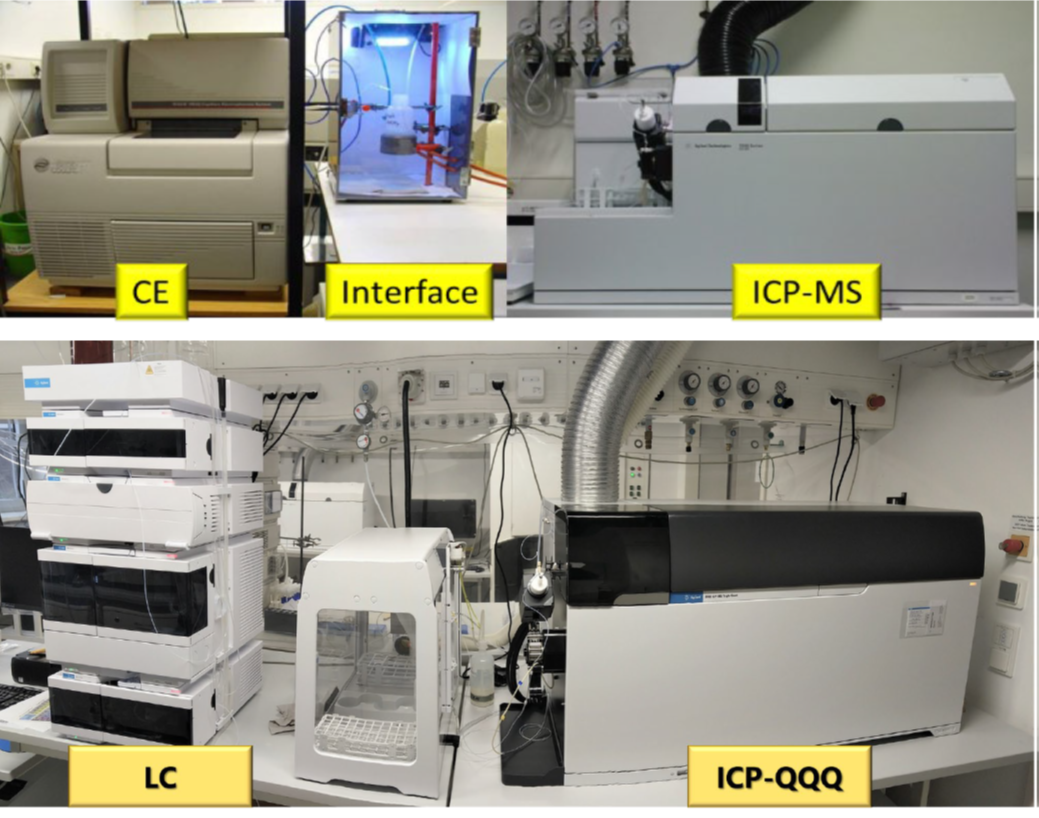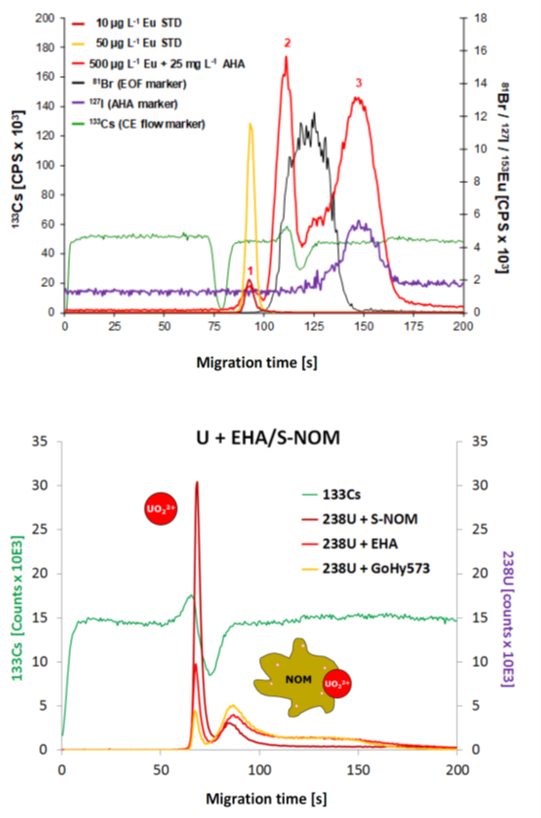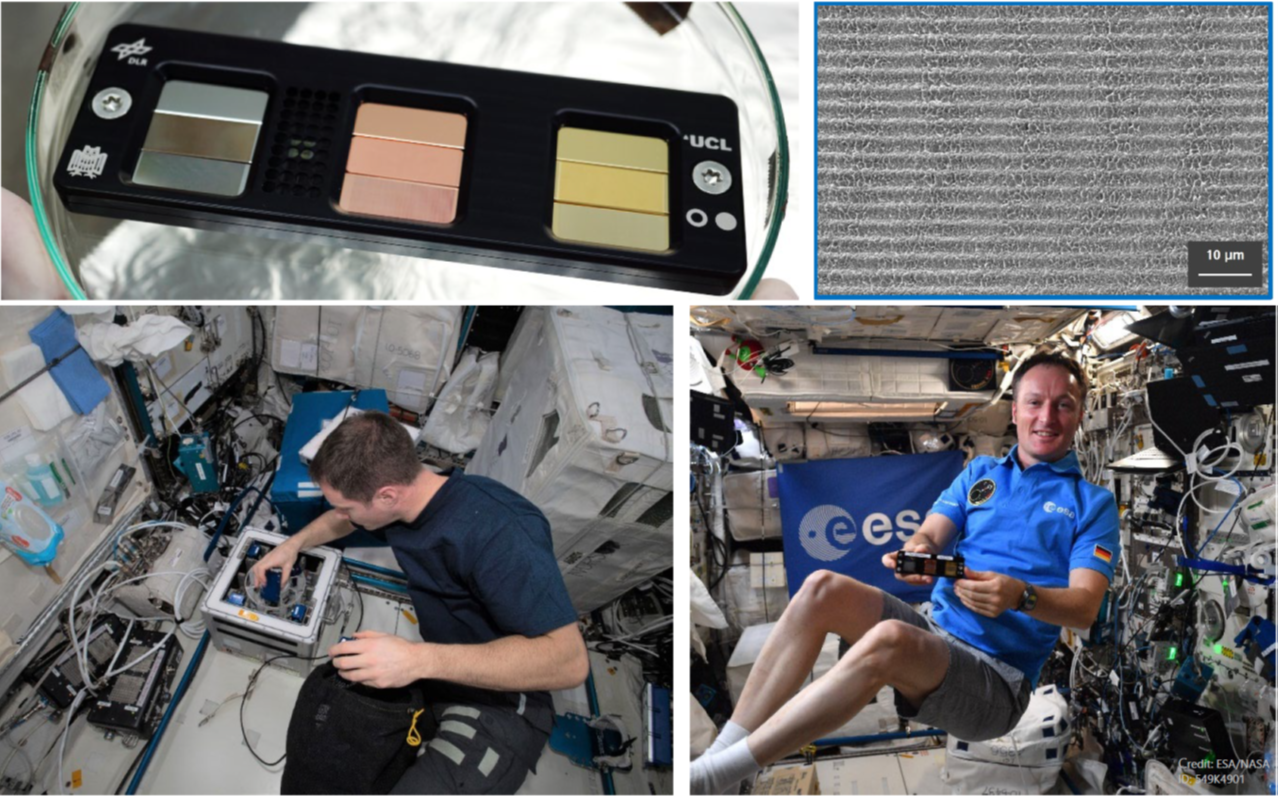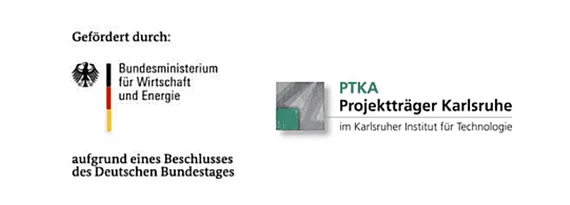Research topics - WASTe (RG Kautenburger)
Hyphenated techniques
Elemental analysis at Saarland University (UdS), and in particular the WASTe working group (Working group for Analytical Speciation Techniques), uses a variety of analytical methods and measurement techniques for elemental analysis and material characterisation i.e. by means of atomic absorption spectroscopy (AAS), inductively coupled plasma optical emission spectroscopy (ICP-OES) and inductively coupled plasma mass spectrometry (ICP-MS and ICP-QQQ).
One focus of elemental analysis is trace element analysis and element speciation by coupling ICP-MS with capillary electrophoresis (CE) and liquid chromatography (LC) using interfaces developed in-house (Fig. 1).
Element speciation
In the context of repository research (see GRaZ I and GRaZ II projects below), for example, the influence of geochemical parameters on the mobility of repository-relevant elements is being investigated as part of the risk assessment regarding the final disposal of high-level radioactive waste in deep geological formations.
The development and application of coupling methods (CE-ICP-MS or LC-ICP-MS) plays a major role here (Fig. 2). By the use of these methods element speciation between repository-relevant metal ions and naturally occurring organic matter (NOM), but also other occurring complex ligands, is investigated,
The coupling methods are set up and optimised, for example, for speciation (complexation) of lanthanides such as europium or gadolinium (as chemical homologues to the actinides) and uranium with organic and inorganic complex ligands. These new methods are then used within our own projects, but also by our collaborative project partners.
One aim of such investigations is to determine sorption and complex stability constants, which are then implemented in databases for geochemical modelling (i.e. for contaminant transport calculations).
Method development
A special focus of elemental analysis at the UdS is the development of new innovative analytical methods. For example, for the first time, a transient ICP-MS measurement methodology could be developed. This method allows the measurement of salt solutions up to 5 M NaCl (corresponding to about 300 g/L, normally by ICP-MS, solutions up to about 0.2 M or 10 g/L NaCl can be measured) with ICP-MS without special sample preparation (Hein, Sander et al. 2017). This transient method (Fig. 3) can be used for many applications where trace element concentrations are to be determined in highly concentrated salt solutions.
Due to the sometimes very complex matrix in our samples (pH > 12, ionic strength up to 5 M), a triple quadrupole device (ICP-QQQ) is essential to suppress the interferences and disturbances that occur. Such a triple quadrupole ICP-QQ together with a liquid chromatography (LC) could be acquired in 2021.
The LC-ICP-QQQ can be used in a variety of ways for our current research (especially for trace element analysis and element speciation through LC coupling) and extended measurement range (applications in the field of NanoBioMed), but also with the extended possibilities for new research tasks at Saarland University.
Mini-column experiments
In addition to a robust and highly detectable transient multi-element method for quantifying trace element contents in highly complex matrices (high salinities and in the hyperalkaline range), a speciation method is often required to investigate the mobility of element species in compact geochemical rock formations or other solids. The so-called mini-column experiments (MCE) developed in the elemental analysis department of the UdS allow the investigation of dynamic sorption or desorption processes of selected elemental species in compact material quasi online with the help of a self-developed LC-MCE-ICP-MS coupling.
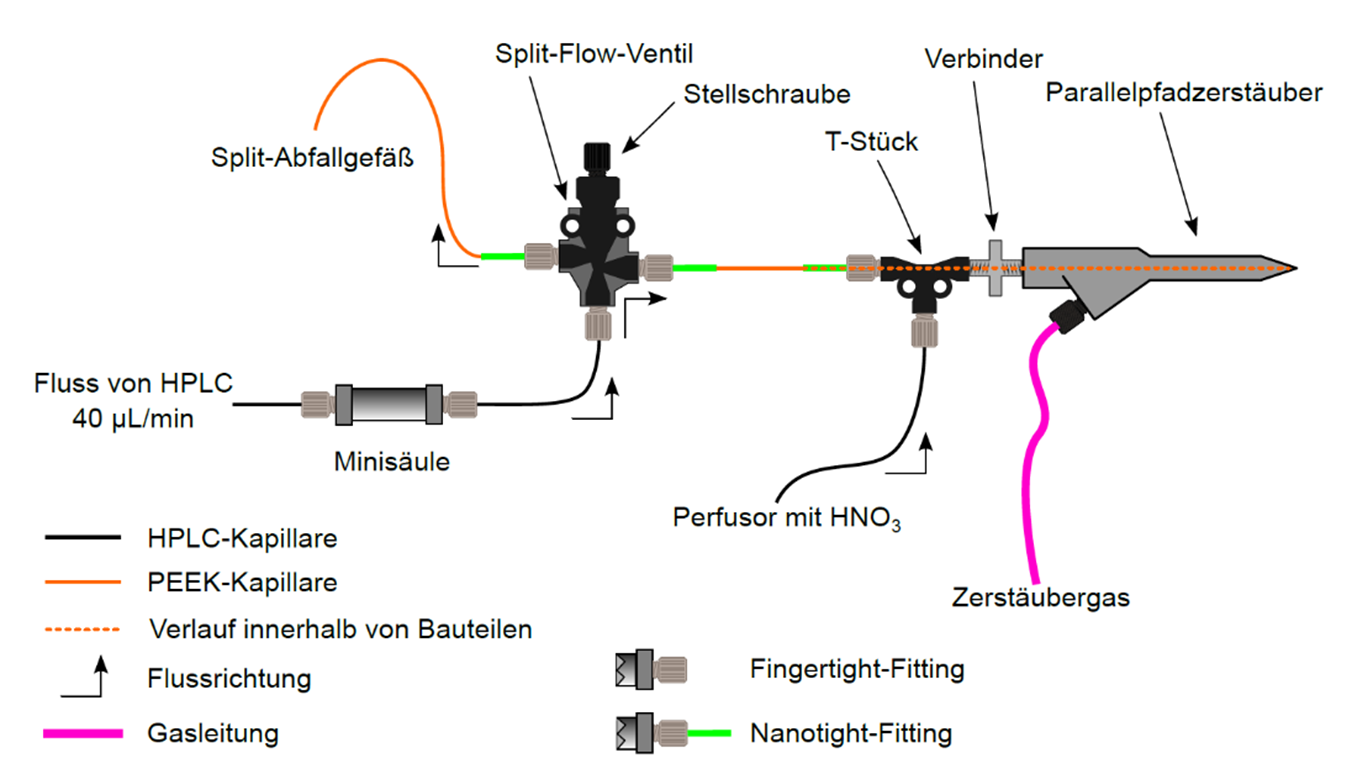
Cooperations
Within the UdS, various research topics have been and are being successfully worked on with various working groups of the NT faculty (see also the topic area of environmental analysis) but also with other departments (in particular with the M faculty of the UdS).
In cooperation with researchers from Saarland University Hospital (UKS), the uptake and distribution of gold nanoparticles in various mouse organs was investigated after intranasal uptakes (Omlor, Le et al. 2016). Based on these studies, the detection of titanium dioxide nanoparticles (TiO2-NP) in mice could be investigated to elucidate the distribution pathways and accumulation rates using ICP-MS (Harfoush, Hannig et al. 2020).
Titanium dioxide nanoparticles have a wide range of applications in various industrial and biomedical fields. For example, it has been shown that workers exposed to inhaled nano-sized TiO2 powder are more susceptible to the risks of developing respiratory diseases. The ICP-MS results on the distribution of TiO2-NP showed that it was present in most organs of both asthmatic and non-asthmatic mice (Fig. 5). As a conclusion from the studies, it could be deduced that intranasal or inhalation exposure to high-dose nanoscale TiO2 particles aggravates allergic airway inflammation and there is systemic uptake into extrapulmonary organs.
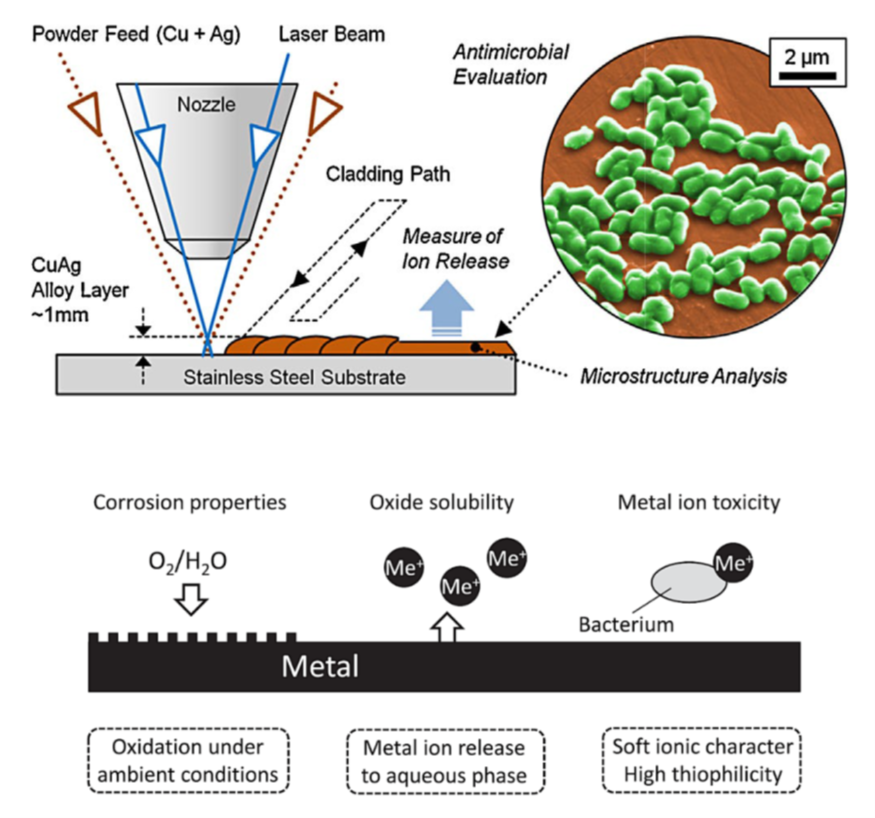
A long-standing cooperation exists with Prof. Dr.-Ing. Frank Mücklich (Chair of Functional Materials, UdS), Prof. Dr. Ralf. Möller (WG Aerospace Microbiology, DLR Cologne) and Dr. Christina Hein (Analytical and Ecological Chemistry, University of Trier) in the field of multi-element screening and leaching behaviour of antibacterial surfaces for the food industry, medicine and space travel (Fig. 6).
Copper and silver, for example, are used in healthcare as antimicrobials to control infections caused by bacteria that are resistant to multiple antibiotics. While the bactericidal potential of copper or silver as individual metals is well documented, not much is known about the antimicrobial properties of copper-silver alloys, which is why the antibacterial activity of different CuAg model alloys in the form of surface coatings on stainless steel was investigated.
Using ICP-MS and ICP-QQQ, the trace levels of released ions from the alloy, their dissolution kinetics and the resulting killing of Escherichia coli under humid conditions were analysed and the results of the alloy were compared with pure silver, pure copper and stainless steel. It was found that the CuAg alloy resulted in a significantly increased kill of E. coli compared to the pure elements. The results showed that a significantly improved antimicrobial property is achieved by surface coating with a CuAg alloy, whereby the coating can also be applied subsequently to already existing surfaces.
The very successful cooperation is currently being continued in the space projects "BIOFILMS" together with Daniel Müller, Frank Mücklich (Functional Materials, UdS), Katharina Siems and Ralf Möller (Space Microbiology, DLR Cologne), as well as within the framework of Spaceship EAC in the project "BIOMINING" together with Marta Cortesão and Ralf Möller (Space Microbiology, DLR Cologne).
For example, on the International Space Station ISS, as part of the "Cosmic Kiss" mission, novel material surfaces structured with laser interference, which were produced at the Institute for Functional Materials at the UdS, are being tested for their antimicrobial effectiveness under space conditions compared to conditions on Earth (Fig. 7).
After their return to Earth, the samples will then be examined analytically, material-scientifically and microbiologically, with the UdS Elemental Analysis WG analysing the element leaching behaviour of the surfaces as well as the element trace contents of the biofilms. The exact experimental design can be read in the publication just published (Siems, Müller et al. 2022).
Service Point Elemental Analysis
Elemental analytics also offers support for a wide range of analytical issues within the framework of research cooperation and contract analytics.
Service Point Elemental Analysis
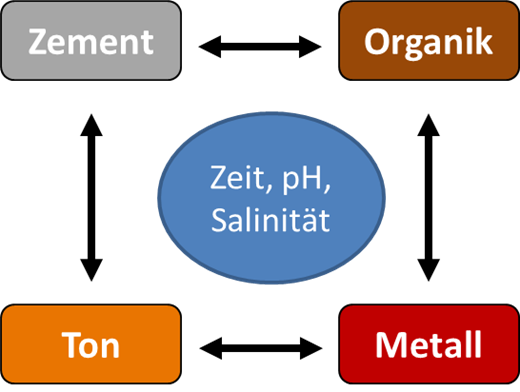
Joint project GRaZ II: "Geochemical radionuclide retention on cement aging phases".
Funded by BMWi (2021-2024)
Overview
The topic of the research project is the retention of radionuclides (actinides) in the near-field of a repository for heat-generating radioactive waste in claystone formations of northern Germany according to the NORD siting model. For the safety demonstration of such a repository, there are knowledge gaps on the influence of dissolved iron, which is released during the corrosion of the emplacement containers, and of organic and silicate ligands resulting from the concrete or cement corrosion of the engineered barrier. A special feature of the NORD site model is the medium to high ionic strength of the formation waters of the clay rock. Therefore, the influence of iron and the organic and silicate ligands on radionuclide retention at cement corrosion phases and the bentonite buffer under hyperalkaline conditions at medium to high ionic strengths is to be quantified. For this purpose, the processes sorption, diffusion, complexation, redox transformation and solubility are studied with experimental and quantum chemical methods, elucidated on the molecular level and described with thermodynamic models. On the basis of the results achieved in this project and the previous joint project "Geochemical radionuclide retention at cement ageing phases (GRaZ I)", it will be critically evaluated to what extent existing findings for systems of low ionic strength are applicable to the conditions of medium to high ionic strength according to the NORD site model.
Subproject D (Saarland University):
"Retention, fixation and remobilisation of repository-relevant elements and element mixtures at cement ageing stages".
The planned research work at the UdS relates in particular to the interactions of radionuclides and their homologues with cement or concrete and their alteration products within the geotechnical barrier of a potential repository under the influence of high-saline and hyperalkaline conditions. The main focus is to investigate the behaviour of repository-relevant elements or element mixtures under different geochemical conditions (formation waters, cement additives and competing ions). The selected elements are U(VI) as nuclear fuel or Mo(VI) as a possible homologous element, Eu(III) as a representative for the trivalent actinides, and Cs(I), Sr(II), Pd(II), Sm(III), Zr(IV) and Ru(IV) as possible degradation or fission products, as structural parts (e.g. cladding tubes or ingot moulds) and as non-radioactive homologous representatives. In addition to single-element experiments, the investigations are mainly carried out with element mixtures ("WASTe cocktail") using multi-element ICP-MS in the concentration range from 10-9 to 10-6 mol/L.
Joint project GRaZ I:
"Geochemical radionuclide retention on cement aging phases".
Subproject D: "Investigation of cement and clay corrosion products and their influence on the retention of repository-relevant elements".
Client: BMWi (2015-2020)
At the beginning of the project, the corrosion products of cement or concrete including organic cement additives were investigated under the conditions of a site in clay rock under high-salinity conditions. In particular, Portland cement with typical organic cement additives was studied. The formation waters formed in contact with medium to high salinities and the corrosion products formed under such conditions were investigated. This work also included the characterization of the hyperalkaline pore waters including the contained organic components by means of ICP-MS and LC-MS as well as the preparation of corresponding synthetic formation waters.
Another focus was on investigations of the interactions of such hyperalkaline waters with the clays used. For this purpose, Opalinus Clay as well as Ca-bentonite (Calcigel), which is intended as buffer material and borehole closure in the repository concept, were used. The aim of the investigations is to determine the retention or mobility of repository-relevant elements (or element mixtures in a composition corresponding to the repository inventory) in the clay under the influence of the formed hyperalkaline formation waters of high ionic strength.
Within the GRaZ I and GRaZ II joint project, intensive cooperation is taking place with the Helmholtz Center Dresden-Rossendorf (Institute for Resource Ecology), the Johannes Gutenberg University Mainz (Institute for Nuclear Chemistry), the Karlsruhe Institute of Technology (Institute for Nuclear Waste Disposal), the Technical University Dresden (Radiation Protection Department), the Technical University Munich (Theoretical Chemistry Department), the University of Heidelberg (Physical Chemistry Institute) and the University of Potsdam (Institute for Chemistry/Physical Chemistry).
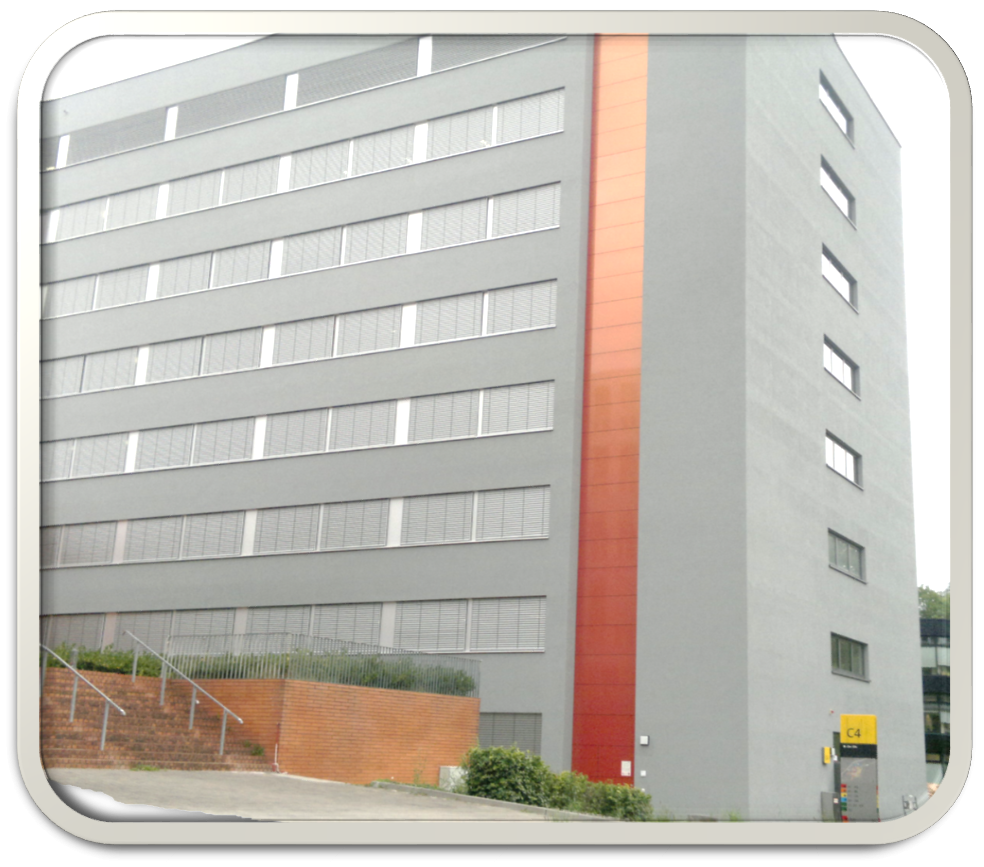
AG WASTe - Elementanalytik
Kontakt und Anfahrt:
apl. Prof. Dr. Ralf Kautenburger
++49 681 302 2171
ralf.kautenburger@uni-saarland.de
Universität des Saarlandes
Anorganische Chemie / Elementanalytik
Campus C4 1, 1. UG
66123 Saarbrücken


